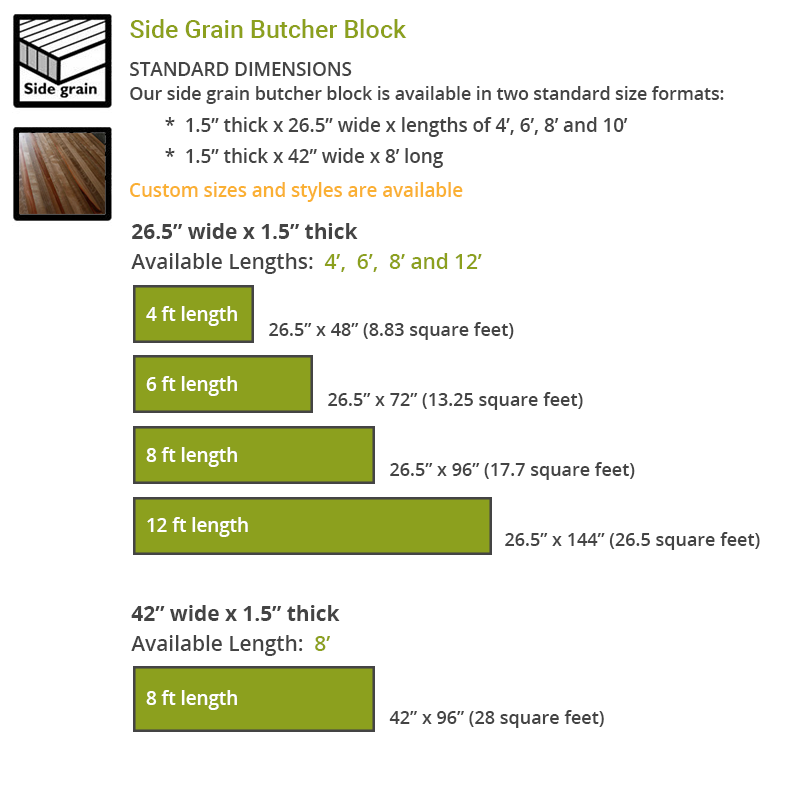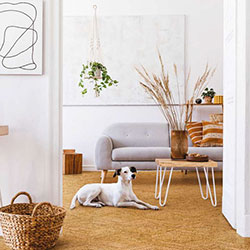Blue Pine Butcher Block Countertop - SIDE GRAIN
Solid Wood Surface - Ready-Made Butcher Block SlabUnfinished
Side Grain
Two Size Formats Available:
- 26.5" wide x lengths of 4', 6', 8' and 10' (1.5" thick)
- 42" wide x 8' long (1.5" thick)
* Custom Sizes and Styles Available
PLEASE CALL TO OBTAIN A QUOTE, A SHIPPING ESTIMATE, OR TO PLACE AN ORDER

Purchase
Call for price
Description
Blue Pine Butcher Block Solid Wood Countertop
ALL DOWNLOADS
- Butcher Block Installation and Care & Maintenance Guide
- Butcher Block VOC Emission Test Certificate
- Butcher Block Limited Warranty
There is nothing like an old-fashioned, butcher block island countertop for the warmth, color, and feel of a solid hardwood surface. The island becomes the center of the kitchen, where everyone congregates while meals are being made. Or overhang one side, stash a few stools underneath, and it becomes a wonderful place to sip coffee while the kids eat breakfast.

Blue Pine
Blue Pine can be any species of pine that acquires a natural blue stain after being infected by the Mountain Pine Beetle. The wood is known for its exceptional blue striping that pops against the creamy vanilla tones of the pine. It looks fantastic in modern spaces, especially when paired with concrete, white tile, or stainless steel.We are proud to partner with small mills that are salvaging beetle-killed pine trees from public parks and campgrounds where the dead standing trees pose a risk to human users. Specifically, we work with Ponderosa and Lodgepole Pine, which are the dominant species in the affected areas.
Side Grain
Side grain is the construction style most commonly used for countertops because it’s strong, stable, and more affordable than the plank or end grain styles. It’s made by placing long boards on their sides and joining them so that their long, narrow, and harder "side" edges form the surface. We don't use leftover lumber, so no short "finger-jointed" pieces or thinner remnants.
Cut-To-Size, Unfinished
Our standard butcher block is unfinished, cut-to-size, and sanded to approximately 120 grit with square edges. However, all unfinished tops can be quoted with fabrication, installation, and finish - just contact us for details!
Or Completely Customizable
We make butcher block of any thickness, any width and any length.The sky's the limit when it comes to our custom capabilities. Use our COUNTERTOP ESTIMATE FORM to request a quote for your vision and we'll help guide the finished product based on production reality and cost.
Custom Options include:
- Edge Details
- Custom Thickness
- Any width or length
- Under or top mount sink/stove cutouts
- Pre-joining edges or seams
- Backsplash
- Electrical wiring chase
- Custom and stacked edge profiles
- Curves or custom shapes
- Knife slots
- Integral drainboards

Finishing your Butcher Block
We offer the perfect blend of Pure Tung Oil and Citrus Solvent for finishing your wooden surface.Find our Half & Half finish by The Real Milk Paint Co. HERE and watch the video tutorial below!
HOW TO FINISH A WOODEN COUNTERTOP
Care and Maintenance of a Butcher Block
Some clients use their butcher blocks as a large cutting board, others treat them like fine furniture. In either case, simply wipe clean with a moist sponge after use. Avoid harsh detergents and puddles of standing water. That's it! Letting the butcher block dry out because of a lack of oil is the top cause of problems with butcher block. Periodically oil the butcher block with your choice of food-grade plant oil. A good rule of thumb is once a week for the first month and then a minimum of monthly thereafter. The frequency of oiling will depend largely on the species of wood, how you use it and what finish was applied. Basically, if the wood appears dry, it's time to oil it.
DOWNLOAD OUR BUTCHER BLOCK INSTALLATION & CARE GUIDE
Natural Oil
Natural Oil finished tops are food grade, you can cut right on them like a cutting board. Because wood is a natural, living material, it continually absorbs more oil, so regular re-oiling will be necessary to maintain its luster. Re-oiling is simple -- just spread oil evenly over the surface, allow it to soak in for about 5 minutes then wipe the excess off with a clean rag. It's that easy!
If light scratches occur, sand the surface gently with 220-grit sandpaper and reapply your food-safe oil.
READY TO START THE PROCESS? START WITH OUR ONLINE COUNTERTOP ESTIMATE FORM - JUST CLICK THE “GET A QUOTE” BUTTON BELOW!


























